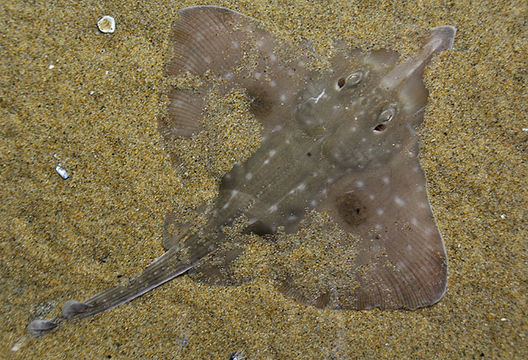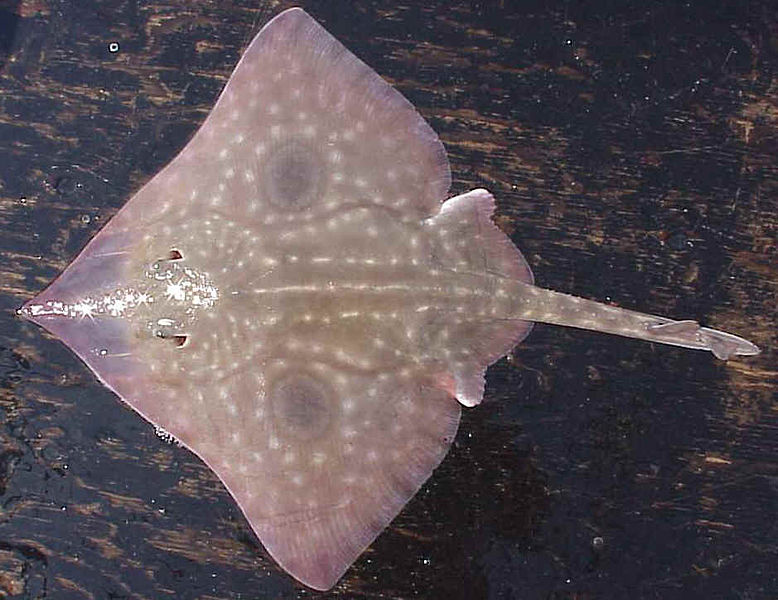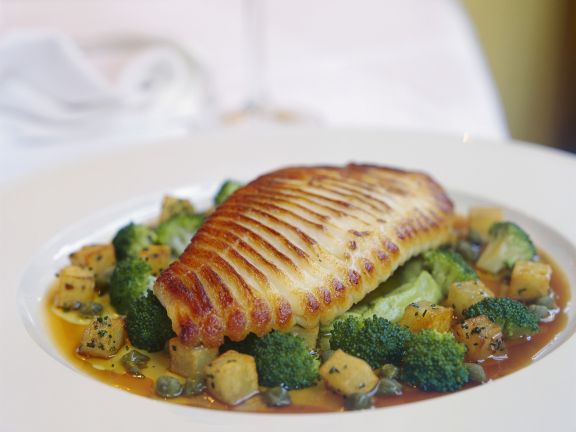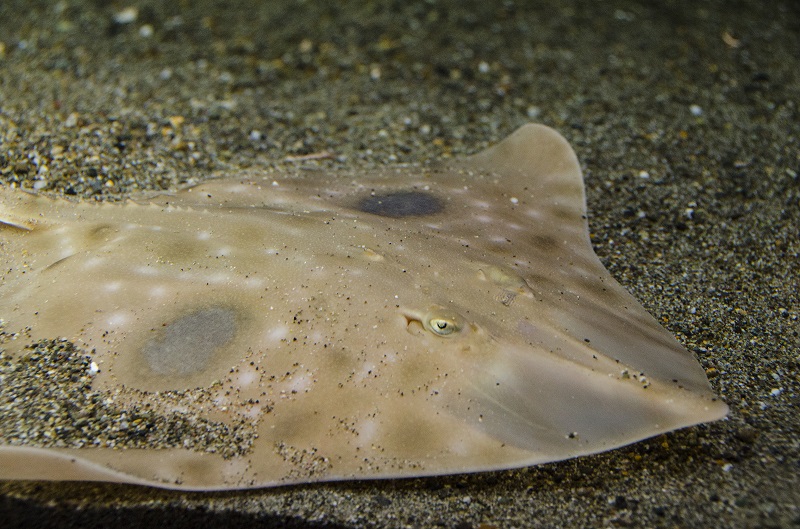The Science

Taxonomic description
- Diamond shaped with a mottled reddish-brown top, scattered small pale spots and larger dark blotches. [1]
- The large “eye spots” on its pectoral fins are thought to confuse predators about its size. [1]
- Can grow up to 2.4 m (~8 ft) long from snout to tail. [1]
Distribution
- Found from the Bering Sea and Southeastern Alaska down to Central Baja California, although rarely found south of Point Conception. [1]
Life history
- Lives up to 17 years old. [2]
- Males and females reach maturity at approximately 7-8 years and 12-13 years, respectively. Females lay large egg capsules which usually contain 3-4 eggs that hatch about 9 months after release. [1]
Habitat
- Commonly found at depths of 100-200m (328-656 ft) in coastal bays and estuaries along sandy or muddy bottoms. [2]
- Feeds on marine invertebrates on the sea floor as well as small fish such as sculpin. It is preyed upon by large bony fish and sharks. [1]
- Elephant seals are known to sometimes eat big skate egg capsules. [1]
The Fishery

Seasonal availability
- Available year-round. [3]
Regulatory and managing authority
-
Big skate is managed federally by the NOAA fisheries and, as established by the Magnuson-Stevens Act, the Pacific Fishery Management Council (PFMC) through the Pacific Coast Groundfish Fishery Management Plan (FMP). [3]
-
As established by the Marine Life Management Act, the California Fish and Game Commission (CFGC) regulates the big skate fishery in state waters, and the California Department of Fish and Wildlife (CDFW) manages this fishery. [7]
-
The California Groundfish Collective combines input from the industry and government entities to inform regulatory and management measures for this fishery. [8]
Gear type
- Usually caught as incidental bycatch by fisheries using trawl, longline, and trammel net gear. [2]
Status of the fishery
- Of least concern due to management throughout much of its range but is at risk of being overfished due to its large body size and slow growth rate. [2]
- Population size has remained stable in the northern part of its range but no formal stock assessment has been to done along the coast of Washington, Oregon, or California. Stock assessments from other regions confirm that the population is stable. [3]
- Within California boundaries, the Marine Life Protection Act (MLPA) limited the range of trawling boats and fishing pressure on this species. [2]
Potential ecosystem impacts
- There are minimal ecosystem impacts as the management plan takes into account fishery-independent biomass estimates and natural mortality estimates. Historically in California, landings of big skate tended to be smaller individuals with larger individuals being discarded, allowing for mature individuals to continue reproducing. [2]
The Seafood

Edible portions
- Typically only the wings are eaten. [4]
Description of meat
- This fish has soft, off-pink meat that usually firms up after being chilled. [4]
Culinary uses
- This fish can be obtained as skinless fillets or whole wings with skin. Each wing produces two fillets, one from the top and one from the bottom. [4]
- If preparing freshly caught skate, cut along the thickest part of the wing where it once joined the body until you hit the layer of cartilage. Slide the knife along the cartilage until the fillet has been removed. Remove the skin the same way you would any other fish. Repeat on other side of the wing. [5]
- Some skate wing recipes can be found on EatSmarter! and Food and Wine. [6,10]
Nutritional information 
- Nutritional info is for one skate fillet. [4]
Toxicity report
- As skate processes urea through the skin, it can develop an ammonia smell if handled improperly. Avoid buying pieces that smell like ammonia and when sport fishing, eliminate gut immediately after obtaining and put on ice. [9]
Seasonal availability
- Available year-round but fresh skate landed in the winter is considered the best. [4]
References
[1] Bester, C. 2018. Raja binoculata. Web. https://www.floridamuseum.ufl.edu/discover-fish/species-profiles/raja-bi.... Accessed 5 September 2018.
[2] Farrugia, T.J. et al. Beringraja binoculata. 2016. The ICUN Red List of Threatened Species. Web. https://www.iucnredlist.org/species/44183/80679344. Accessed 14 August 2020.
[3] Pacific Coast Groundfish Fishery Management Plan. 2019. Pacific Fishery Management Council. Web. https://www.pcouncil.org/documents/2016/08/pacific-coast-groundfish-fish.... Accessed 17 August 2020.
[4] Skate. Seafood Source. 2014. Web. https://www.seafoodsource.com/seafood-handbook/finfish/skate. Accessed 5 September 2018.
[5] Filleting Skate Wings. 2018. Web. https://www.brownetrading.com/how-to/filleting-skate-wings/. Accessed 5 September 2018.
[6] Skate with Capers and Brown Butter. 2014. Food & Wine. Web. https://www.foodandwine.com/recipes/skate-capers-and-brown-butter. Accessed 17 August 2020.
[7] Marine Life Management Act. n.d. Web. https://wildlife.ca.gov/conservation/marine/mlma. Accessed 28 October 2020.
[8] California Groundfish Collective. n.d. Web. http://www.cagroundfish.org/#our-story. Accessed 28 October 2020.
[9] Oulton, R. 2007. Skate. Web. http://www.cooksinfo.com/skate. Accessed: 20 May 2017.
[10] EatSmarter! n.d. Grilled Skate Wing with Potato and Broccoli. Web. Accessed 12 February 2021.

